Cost £4.6 million each | Preceded by Ton class In commission 1984–2001 | |
 | ||
Builders Richards Dry Dock and Engineering Limited Operators | ||
The River class was a class of minesweeper built for the British Royal Navy in the 1980s, designated Fleet Minesweepers (MSF).
Contents
Design
The Rivers were built with a traditional steel hull to a design based on a commercial offshore support vessel. The class was designed to be operated as deep sea team sweepers, to combat the threat posed to submarines by Soviet deep-water buoyant moored mines codenamed "Cluster Bay".
The River-class MSF was equipped with the Wire Sweep Mark 9 (WS 9) which was capable of performing Extra Deep Armed Team Sweeping (EDATS). Operating in pairs (or a number of pairs in formation), they towed a sweep between the two ships that followed the profile of the bottom and cut the mooring wires of the mines; these released mines would then be destroyed on the surface with gunfire. The WS 9 was able to be used for mechanical sweeping in this manner or influence sweeping whereby a transducer was towed through the water generating noise, both acoustic and electro-magnetic, that simulated a larger high value unit. The Rivers were also armed with a single 40 mm Bofors gun on the manually operated World War II-era Mark III mounting, and two L7 GPMGs.
The concept was refined in the chartered trawlers HMS St David and HMS Venturer, and a total of twelve vessels, all named after British rivers, were constructed by Richards Shipbuilders at Lowestoft and Great Yarmouth at an approximate unit cost of £4.6 million. The class was designed to operate in deep water and ocean environments, if necessary for long periods of time without support. The complement was 5 officers, 7 Senior Ratings, and 16 Junior Ratings, although additional accommodation meant that a total crew of 36 could be borne for training purposes.
Service history
Upon entering service they joined the 10th Mine Countermeasures Squadron based at Rosyth and eleven were assigned to various Royal Naval Reserve (RNR) divisions around the United Kingdom. The twelfth, Blackwater, entered service with the regular Royal Navy. Following defence cuts, Helmsdale and Ribble were paid off in 1991 and were laid up at Portsmouth. Further cuts followed when the future of the RNR was reviewed in 1993 and as a result the entire class was withdrawn from RNR service.
Blackwater, Spey, Arun and Itchen were subsequently assigned to the Northern Ireland Squadron where they replaced Ton-class vessels patrolling the province's waterways and participating in counter-terrorist operations in support of the British Army and the Royal Ulster Constabulary (RUC). Orwell replaced Wilton, the last Ton-class vessel in service, as the Dartmouth Training Ship in 1994. Ultimately, the entire class was sold to overseas navies.
